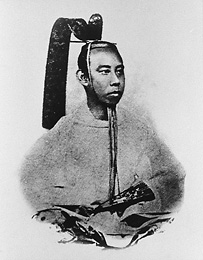Matsudaira Shungaku was born on October 10, 1828 in Edo, Japan and died on June 2, 1890 in Tokyo, Japan. He went by several names including Matsudaira Keiei and Matsudaira Yoshinaga. Although he was adopted, when Matsudaira Narisawa died without an heir, he became the next daimyo of Echizen province, later Fukui prefecture. 
Matsudaira Shungaku was a daimyo during the Edo Period in Japan and is considered to be one of the “Four Wise Lords of the Bakumatsu Period.” Although he held a major role in Bakumatsu politics, the daimyo period ended once the Meiji Restoration began. Nonetheless, Shungaku held many responsibilities in order to protect the Shogun and was therefore named seiji sôsaishoku, an important government official, due to his significant duties.
Matsudaira Shungaku was considered progressive for his ideas in both politics and education. Shungaku, along with other Japanese, encouraged the adoption of a democratic form of government. Regarding the field of academics, Shungaku invited Rutgers alumnus and educator, William Elliot Griffis in 1870 to restructure the Japanese education system in a more modern, western light. At the school in Fukui, Griffis taught the physical sciences as an oyatoi gaikokujin, or “foreign employee.” A joint effort between Shungaku and Griffis also led to the creation of the “New Japan Series of Reading and Spelling Books” in 1872, which was comprised of five volumes.
Today, the Fukui City History Museum in Japan pays its respects to Matsudaira Shungaku and the important contributions he made throughout the modernization of Japan. The statue of Shungaku at the museum’s entrance and the modern replica of his villa seems to preserve his legacy, as if mirroring his last words in 1890, which were “Even if I become one of countless souls, I would soar up to heaven and protect Emperor’s reign for our nation.”
References:
Ishin Shiryô Kôyô 維新史料綱要, vol 1 (1937), 402.
Daniele Lauro, “Displaying authority: Guns, political legitimacy, and martial pageantry in Tokugawa Japan, 1600 – 1868,” MA Thesis, University of North Carolina, Chapel Hill (2013), 31-32.
Tokugawa Reiten Roku 徳川禮典録, vol 1., Tokyo: Owari Tokugawa Reimeikai (1942), 1-2.